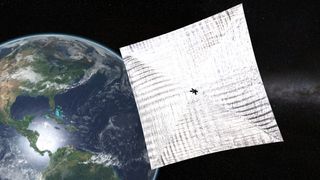
A solar sail mission funded entirely by private citizens will launch to Earth orbit just a few months from now.
The nonprofit Planetary Society announced today (Jan. 26) that its first LightSail spacecraft will blast off atop a United Launch Alliance Atlas V rocket in May from Florida's Cape Canaveral Air Force Station, to test out critical systems and technologies ahead of a more involved solar sailing trial in 2016.
“There's an old saying in aerospace: 'One test is worth a thousand expert opinions,'" Planetary Society CEO and TV "Science Guy" Bill Nye said in a statement. "After six years of development, we're ready at last to see how LightSail flies." [Photos: Solar Sail Evolution for Space Travel]
"LightSail is technically wonderful, but it's also wonderfully romantic. We'll sail on sunbeams," Nye added. "But wait; there's more: This unique, remarkable spacecraft is funded entirely by private citizens — people who think spaceflight is cool."
As Nye said, solar sails work by harnessing solar radiation pressure, which imparts a very small but continous push. Over time, this gentle push can accelerate a sailing craft to very high speeds, without the need for any onboard propellant.
LightSail is a tiny CubeSat; at launch, the spacecraft will be about as big as a loaf of bread. After it reaches orbit, LightSail will undergo a four-week checkout phase, and then will deploy four triangular sails, which together will cover an area of 344 square feet (32 square meters).
But LightSail won't fly high enough to do any bona fide solar sailing on this first test run; atmospheric drag will probably pull the spacecraft down two to 10 days after sail deployment, Planetary Society representatives said.
Get the Space.com Newsletter
Breaking space news, the latest updates on rocket launches, skywatching events and more!
The mission should return valuable data about LightSail's attitude-control and sail systems — information that will help engineers developing the second LightSail craft, which is due to launch on a full solar-sailing demonstration mission in 2016. (That mission is scheduled to fly on the first operational liftoff of SpaceX's Falcon Heavy rocket.)
LightSail won't be the first solar-sailing craft to make it to space. That distinction goes to Japan's Ikaros probe, which unfurled its 46-foot-wide (14 m) sail in June 2010. NASA launched a solar sail demonstration mission called NanoSail-D a few months later, in November 2010. (The Planetary Society's Cosmos 1 spacecraft aimed to be the first-ever solar-sailing probe, but its mission ended with a rocket failure in 2005.)
NASA had been planning to launch another solar sail mission, called Sunjammer, in early 2015. But the agency canceled the project late last year because of concerns that the primary contractor, California-based company L'Garde, wouldn't be able to deliver the spacecraft on time.
LightSail will travel as a secondary payload on the May launch. The Atlas V's primary payload on the mission is classified, Planetary Society representatives said.
Follow Mike Wall on Twitter @michaeldwall and Google+. Follow us @Spacedotcom, Facebook or Google+. Originally published on Space.com.
Join our Space Forums to keep talking space on the latest missions, night sky and more! And if you have a news tip, correction or comment, let us know at: community@space.com.

Michael Wall is a Senior Space Writer with Space.com and joined the team in 2010. He primarily covers exoplanets, spaceflight and military space, but has been known to dabble in the space art beat. His book about the search for alien life, "Out There," was published on Nov. 13, 2018. Before becoming a science writer, Michael worked as a herpetologist and wildlife biologist. He has a Ph.D. in evolutionary biology from the University of Sydney, Australia, a bachelor's degree from the University of Arizona, and a graduate certificate in science writing from the University of California, Santa Cruz. To find out what his latest project is, you can follow Michael on Twitter.
